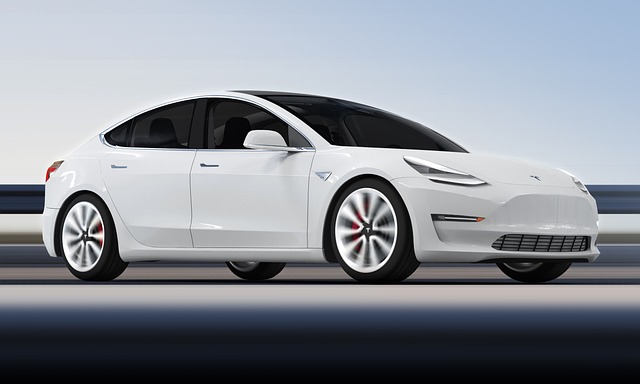Adopting Select Electric Vehicles (SEVs) offers businesses significant environmental and financial benefits, reducing carbon footprints with zero tailpipe emissions. Lower operational costs, diverse options tailored to various needs, and expanding charging infrastructure make SEVs a convenient choice. Governments incentivize SEV adoption with subsidies, tax breaks, grants, and affordable leasing options. Leaders like UPS and FedEx demonstrate enhanced efficiency and performance while transitioning to green energy logistics. This shift towards SEVs is both an environmental responsibility and a smart business strategy.
In today’s eco-conscious world, exploring sustainable fleet options is no longer a choice but a necessity. This comprehensive guide delves into the transformative power of green fleets, shedding light on their significant environmental impact. We explore the myriad benefits of adopting electric fleets, from reduced emissions to cost savings. Discover the various types of electric vehicles tailored for commercial use and gain insights into charging infrastructure and government incentives driving this sustainable transition. Real-world case studies showcase successful fleet transitions, inspiring businesses to make eco-friendly choices with Select Electric Vehicles.
- Understanding the Impact of Fleet Vehicles
- Benefits of Adopting Electric Fleets
- Types of Electric Vehicles for Commercial Use
- Charging Infrastructure and Its Role
- Government Incentives and Support
- Case Studies: Successful Sustainable Fleet Transitions
Understanding the Impact of Fleet Vehicles

Fleet vehicles play a significant role in shaping our environmental footprint, especially with the growing concerns over climate change. Understanding the impact of these vehicles is the first step towards adopting more sustainable practices. Traditional fleet operations often rely heavily on fossil fuels, contributing to air pollution and greenhouse gas emissions. This has led to a push for greener alternatives, with electric vehicles (EVs) emerging as a popular choice. By selecting electric vehicles, businesses can significantly reduce their carbon footprint, as EVs produce zero tailpipe emissions.
The shift towards sustainability in fleet management is not just an environmental imperative but also presents practical benefits. For instance, electric school bus programs and sustainable commercial vehicle rentals are gaining traction, offering cost-effective solutions for various transportation needs. Moreover, the availability of affordable electric SUVs for families demonstrates that eco-friendly options can cater to diverse markets without compromising on performance or comfort. This trend towards electrification offers a promising path toward a more sustainable future, where fleet vehicles contribute positively to our living environment.
Benefits of Adopting Electric Fleets

Adopting electric fleets offers a myriad of benefits for businesses and organizations looking to reduce their environmental impact and lower operational costs. By selecting electric vehicles (EVs), companies can contribute significantly to sustainability goals, as EVs produce zero tailpipe emissions, helping to improve air quality and combat climate change. This shift also leads to substantial financial savings due to the reduced cost of electricity compared to traditional fuels, especially with the growing availability of affordable EV models.
Additionally, electric school bus programs and the increasing popularity of best long range electric cars have made rapid charging electric cars more accessible and convenient. The infrastructure for rapid charging is expanding, making it easier for fleet operators to recharge their vehicles quickly and efficiently. This advancement addresses a common concern among EV adopters, ensuring that transitioning to electric fleets is not just an environmentally conscious choice but also a practical and feasible one.
Types of Electric Vehicles for Commercial Use

In today’s world, where sustainability is at the forefront of many industries, businesses are increasingly looking to green energy vehicle options to power their fleets and reduce their environmental impact. One prominent choice in commercial transportation is the electric vehicle (EV). Select Electric Vehicles offer a wide range of benefits, from lower operational costs to reduced emissions. For instance, long range electric buses for public transport are becoming more common, providing an efficient and eco-friendly alternative to traditional diesel-powered buses. These zero-emission vehicles not only contribute to cleaner air but also offer quieter operations, making them ideal for urban settings.
Additionally, the variety of EV types available ensures that businesses can find suitable green energy logistics and shipping options tailored to their specific needs. From smaller electric vans perfect for local deliveries to larger trucks capable of long-haul transportation, these vehicles are revolutionizing the way companies manage their fleets. With advancements in battery technology, many modern EVs offer impressive ranges, addressing previous concerns about limited travel distances. This shift towards sustainable fleet options is not just a trend but a necessary step towards a greener future for the transportation sector.
Charging Infrastructure and Its Role

The expansion of electric vehicle (EV) adoption heavily relies on accessible and robust charging infrastructure. As more individuals and businesses opt for sustainable mobility solutions, including select electric vehicles (SEVs), the demand for convenient charging options will increase. Investing in widespread public charging stations is pivotal to encouraging EV ownership and reducing range anxiety, a significant barrier for prospective buyers.
With top-rated electric cars under $30,000 becoming increasingly available, the market is poised for a shift towards best long-range electric cars. This trend necessitates a corresponding growth in charging infrastructure to support these advanced vehicles, ensuring that sustainable transportation remains accessible and convenient for all.
Government Incentives and Support

Many governments worldwide are actively encouraging the adoption of sustainable fleet options by offering enticing incentives and support systems. One prominent strategy is the promotion of Select Electric Vehicles (SEVs) through various subsidies, tax breaks, and grants. These financial stimulants significantly reduce the upfront costs associated with purchasing electric vehicles (EVs), making them a more accessible and affordable option for businesses and individuals.
The availability of affordable electric car leasing options and attractive trade-in values for traditional vehicles further adds to the appeal. With support from governments, EV leasing becomes an economically viable alternative to conventional fuel-based vehicles, especially for urban commuting purposes. This shift towards sustainable transportation is not only beneficial for the environment but also contributes to a more efficient and cost-effective fleet management system.
Case Studies: Successful Sustainable Fleet Transitions

Many businesses are witnessing the benefits of sustainable fleet transitions, setting an example for others to follow in their pursuit of a greener future. Case studies of successful transformations highlight the effectiveness of selecting electric vehicles as a strategic move towards sustainability. For instance, companies like UPS and FedEx have made significant strides by adopting electric delivery vans, demonstrating that eco-friendly practices can enhance operational efficiency without compromising performance. These pioneers prove that electric cars with excellent range and performance are not just an ideal but a feasible reality for daily operations.
The shift towards sustainable fleets is further encouraged by green energy logistics and shipping options becoming more accessible and affordable. Government incentives and rebates, coupled with growing consumer demand, are driving the market to embrace green vehicle technology. As businesses witness the positive impact on their bottom line and brand reputation, it becomes evident that a transition to electric fleets is not just an environmental responsibility but a smart business decision.
In conclusion, transitioning to sustainable fleet options, particularly selecting electric vehicles, offers significant environmental and economic benefits. By understanding the impact of fleet vehicles, adopting electric fleets, and leveraging charging infrastructure along with government incentives, businesses can successfully navigate this transition. Successful case studies demonstrate that embracing these changes not only reduces carbon footprints but also enhances operational efficiency and fosters a greener future for all.
